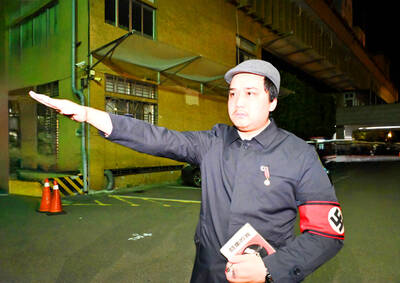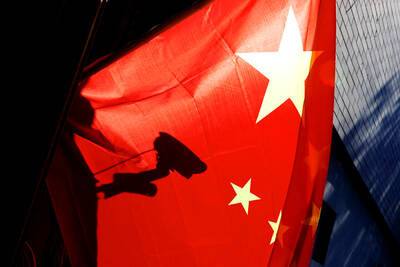Another poll, released yesterday, showed the Democratic Progressive Party's (DPP) presidential ticket featuring President Chen Shui-bian (陳水扁) and Vice President Annette Lu (呂秀蓮) to be neck-and-neck with the pan-blue ticket featuring Chinese Nationalist Party (KMT)Chairman Lien Chan (連戰) and People First Party Chairman James Soong (宋楚瑜).
The poll conducted by the pro-blue China Times newspaper comes in the wake of another conducted by the DPP, released last Friday, showing similar results.
The China Times poll, conducted on Dec. 5 showed that public support for the Chen-Lu ticket was 34 percent, while that of the KMT-PFP Lien-Soong ticket stood at 36 percent. However, about 30 percent of those questioned remained undecided.
The poll also found that after tense partisan feuding over the passage of the Referendum Law the pan-green and pan-blue camps still managed to maintain their base of support.
Analysis of the poll indicated that both the ruling and opposition camps have mobilized their rank-and-file supporters in great intensity, especially the DPP which has conducted its mobilization with the most vigor.
Analysis also suggested that Chen's increased support was due to his appeal to a Taiwan-centered consciousness. This was highlighted by both aa large-scale march in October organized by the pan-green camp in support of the referendum law and a new constitution as well as the battle for the referendum law in the legislature, the newspaper said.
The same survey showed, that given the choice of identifying themselves as Taiwanese, Chinese or both Taiwanese and Chinese, the proportion of people identifying themselves as Taiwanese had risen from 37 percent in late October to 50 percent.
Those who considered themselves both Taiwanese and Chinese had dropped from 48 percent in late October to 38 percent.
The poll did not, however, show the figures for people identifying themselves as Chinese.
Chen's campaign was in buoyant mood after the release of the poll.
DPP Deputy Secretary General Lee Ying-yuan (李應元) comparing details of Chen's national support rate in the 2000 presidential election wit the results of recent polls, said Chen's popularity had gained steadily nation-wide, especially in central Taiwan's Taichung, Changhua and Nantou counties and the southern Taiwan's Kaohsiung City, Kaohsiung County and Pingtung County.
Analyzing the recent gains in public support, director of the DPP's Public Opinion Survey Center Chen Chun-lin (陳俊麟) said the strengthening of support in southern Taiwan was largely as a result of the use of sovereignty-related strategies, such as the holding of a "defensive referendum."
Chen Chun-lin said people in central Taiwan tended to be more concerned with the government's ability to initiate and complete local infrastructure construction and were favorably impressed by the DPP's record.
In the Hakka-populated Miaoli, Hsinchu and Taoyuan areas, he said that, since the Hakka communities were highly clannish, the party would focus on expanding connections with local Hakka clan leaders.
As for the urban Taipei area, where a majority of residents are mainlanders and as a result the area has shown more support for the pan-blue ticket, Chen Chun-lin said the city's residents were more influenced by the media which has been widely criticized for its pan-blue bias.

SECURITY: As China is ‘reshaping’ Hong Kong’s population, Taiwan must raise the eligibility threshold for applications from Hong Kongers, Chiu Chui-cheng said When Hong Kong and Macau citizens apply for residency in Taiwan, it would be under a new category that includes a “national security observation period,” Mainland Affairs Council (MAC) Minister Chiu Chui-cheng (邱垂正) said yesterday. President William Lai (賴清德) on March 13 announced 17 strategies to counter China’s aggression toward Taiwan, including incorporating national security considerations into the review process for residency applications from Hong Kong and Macau citizens. The situation in Hong Kong is constantly changing, Chiu said to media yesterday on the sidelines of the Taipei Technology Run hosted by the Taipei Neihu Technology Park Development Association. With

A US Marine Corps regiment equipped with Naval Strike Missiles (NSM) is set to participate in the upcoming Balikatan 25 exercise in the Luzon Strait, marking the system’s first-ever deployment in the Philippines. US and Philippine officials have separately confirmed that the Navy Marine Expeditionary Ship Interdiction System (NMESIS) — the mobile launch platform for the Naval Strike Missile — would take part in the joint exercise. The missiles are being deployed to “a strategic first island chain chokepoint” in the waters between Taiwan proper and the Philippines, US-based Naval News reported. “The Luzon Strait and Bashi Channel represent a critical access

‘FORM OF PROTEST’: The German Institute Taipei said it was ‘shocked’ to see Nazi symbolism used in connection with political aims as it condemned the incident Sung Chien-liang (宋建樑), who led efforts to recall Democratic Progressive Party (DPP) Legislator Lee Kun-cheng (李坤城), was released on bail of NT$80,000 yesterday amid an outcry over a Nazi armband he wore to questioning the night before. Sung arrived at the New Taipei City District Prosecutors’ Office for questioning in a recall petition forgery case on Tuesday night wearing a red armband bearing a swastika, carrying a copy of Adolf Hitler’s Mein Kampf and giving a Nazi salute. Sung left the building at 1:15am without the armband and apparently covering the book with a coat. This is a serious international scandal and Chinese

COUNTERINTELLIGENCE TRAINING: The ministry said 87.5 percent of the apprehended Chinese agents were reported by service members they tried to lure into becoming spies Taiwanese organized crime, illegal money lenders, temples and civic groups are complicit in Beijing’s infiltration of the armed forces, the Ministry of National Defense (MND) said in a report yesterday. Retired service members who had been turned to Beijing’s cause mainly relied on those channels to infiltrate the Taiwanese military, according to the report to be submitted to lawmakers ahead of tomorrow’s hearing on Chinese espionage in the military. Chinese intelligence typically used blackmail, Internet-based communications, bribery or debts to loan sharks to leverage active service personnel to do its bidding, it said. China’s main goals are to collect intelligence, and develop a